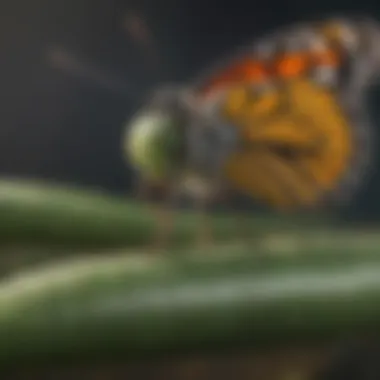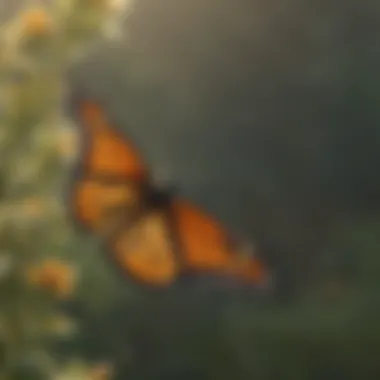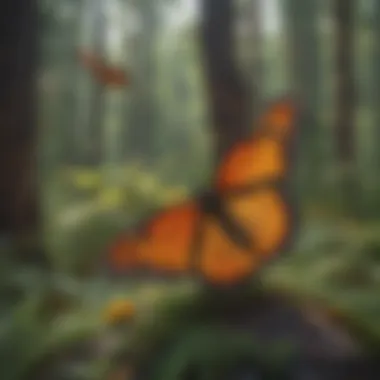Unlocking the Enigma: Unraveling Monarch Butterfly Migration Patterns


Overview of the Topic
Monarch butterflies 🦋 are renowned for their remarkable migration patterns to the north, a natural spectacle that captivates researchers, conservationists, and admirers alike. This section will lay the foundation for understanding the intricacies of this phenomenon, delving into the key points that underline the significance of monarch butterfly migration.
Monarch butterflies, with their distinctive orange and black wings, embark on a rigorous journey from their breeding grounds in North America to their wintering grounds in Mexico. This annual migration is a critical aspect of their life cycle, influenced by environmental factors, seasonal changes, and the need to find suitable habitats for survival.
Current Status and Challenges
As monarch butterfly populations face various threats and challenges, it is crucial to examine the current state of their migration patterns. Climate change, habitat loss, pesticides, and disruptions along their migratory routes pose significant risks to the monarch butterfly population. Understanding these challenges is essential for implementing effective conservation measures to protect these iconic butterflies.
Sustainable Solutions
Exploring sustainable practices and solutions is imperative to address the pressing issues affecting monarch butterflies. Efforts such as establishing milkweed corridors, creating butterfly-friendly habitats, and promoting awareness about the importance of conservation play a vital role in safeguarding monarch butterfly populations. By showcasing successful case studies and initiatives, we can inspire communities to engage in conserving these delicate creatures.
Impact and Importance
The impact of monarch butterfly migration extends beyond the butterflies themselves, impacting ecosystems, communities, and future generations. By analyzing the ripple effects of their presence, we gain a deeper appreciation for the interconnectedness of species within our environment. Emphasizing the importance of conservation efforts and sustainable resource management is paramount to preserving the beauty and biodiversity that monarch butterflies bring to our world.
Introduction
The migration patterns of Monarch Butterflies stand as a captivating spectacle in the realm of natural wonders. Within the intricate tapestry of nature's phenomena, the northward migration of these delicate creatures emerges as a fascinating journey worth delving into. Understanding the nuances and complexities of this migration not only enriches our knowledge but also unveils crucial insights into the interconnectedness of ecosystems.
Overview of Monarch Butterflies
Monarch Butterflies possess a set of physical characteristics that not only define their unique beauty but also contribute significantly to their migratory behavior. From their striking orange and black wings to their lightweight bodies, these butterflies exhibit adaptations that aid them in their arduous journey north. The resilience embedded in their physical structure allows them to traverse vast distances, making them a prime subject for exploration within this article.
Physical Characteristics of Monarch Butterflies
The physical characteristics of Monarch Butterflies play a pivotal role in their migration. Their vibrant coloration acts as a form of protection, warning predators of their unpalatability due to toxins ingested during the larval stage. Additionally, their light body mass enables them to travel long distances without overexertion, making them well-suited for their migratory endeavors.
Importance of Monarch Butterflies in Ecosystems
Monarch Butterflies hold a vital ecological role within their respective ecosystems. As important pollinators, these butterflies aid in the reproduction of various plant species, fostering biodiversity. Their presence in ecosystems acts as a barometer of environmental health, making their conservation crucial for the stability of natural communities.
Migration as a Fascinating Phenomenon
The migration of Monarch Butterflies stands as a testament to the captivating nature of this phenomenon. Defined by a cyclical movement in search of favorable conditions, butterfly migration showcases a remarkable aspect of their life cycle. Exploring the reasons behind this behavior offers valuable insights into the inner workings of these remarkable creatures.


Definition of Migration in Butterflies
Migration in butterflies refers to the seasonal movement from one geographical location to another. In the case of Monarch Butterflies, this migration holds immense significance as it determines their survival and reproductive success. Understanding the mechanisms behind butterfly migration sheds light on the evolutionary adaptations that have shaped this behavior.
Purpose of Monarch Butterfly Migration
The purpose of Monarch Butterfly migration lies in securing suitable habitats for breeding and survival. By migrating to regions with optimal conditions, Monarchs ensure access to resources necessary for their offspring's development. This synchronized movement not only guarantees their species' perpetuation but also showcases the meticulous planning ingrained in their natural instincts.
Factors Influencing Monarch Butterfly Migration
Understanding the intricacies of factors that influence monarch butterfly migration is pivotal in comprehending the complexities of this natural occurrence. These factors play a crucial role in dictating the timing, routes, and overall success of the migration process. By delving into environmental triggers, genetic predisposition, and food availability, one can gain profound insights into the mechanisms driving monarch butterfly migration.
Environmental Triggers
Role of Day Length and Temperature
Day length and temperature are fundamental environmental triggers that significantly impact the initiation and progression of monarch butterfly migration. The fluctuation in these environmental cues serves as a biological clock for monarchs, signaling the appropriate time to commence their journey. With daylight and temperature changes acting as critical navigational aids, monarchs strategically time their migration to optimize survival and breeding prospects. The synchrony between these triggers and the butterfly's biological rhythms underscores the intricate adaptation to their surroundings for efficient migration.
Impact of Weather Patterns
Weather patterns exert a profound influence on monarch butterfly migration dynamics. Variations in weather conditions, such as wind patterns, precipitation levels, and temperature extremes, can both facilitate or impede the monarchs' migratory progress. Favorable weather conditions enable smoother flight patterns, aiding in energy conservation and reduced risks during the journey. Conversely, adverse weather phenomena pose challenges, affecting flight efficiency, foraging opportunities, and overall survival rates of these delicate creatures.
Genetic Predisposition
Inherited Traits for Migration
The genetic predispositions embedded in monarch butterflies drive their ability to undertake extensive migratory journeys. Inherited traits for migration encompass a suite of genetic characteristics that govern the monarch's migratory behavior. These hereditary features equip the butterflies with specialized adaptations, such as enhanced navigational abilities, improved energy storage mechanisms, and optimized flight efficiency. The interplay between genetics and migration underscores the evolutionary strategies honed over generations that ensure successful migration of monarch populations.
Evolutionary Adaptations
Evolutionary adaptations in monarch butterflies reflect a legacy of survival tactics finely tuned to optimize migration success. These adaptations manifest in physiological changes that enhance the butterfly's resilience to environmental stressors encountered during migration. Traits like increased fat storage capacity, streamlined body morphology for efficient flight, and innate orientation skills are hallmarks of the monarch's evolutionary journey. Through gradual adaptations, monarch butterflies have honed their biological mechanisms to cope with the rigors of long-distance migration.
Food Availability
Connection between Milkweed Plants and Migration
The intricate relationship between milkweed plants and monarch butterfly migration highlights the critical reliance of these butterflies on specific host plants. Milkweed serves as the primary food source and breeding ground for monarchs, shaping their migratory patterns and reproductive success. The presence of milkweed along migration routes acts as waypoints for the butterflies, guiding their journey and providing essential sustenance. The symbiotic bond between monarchs and milkweed underscores the interdependence between plant species and insect migrations in maintaining ecological balance.
Nutritional Needs During Migration
Nutritional requirements during migration are paramount for sustaining the energy demands of monarch butterflies throughout their journey. The intricate balance of macronutrients, micronutrients, and hydration levels is essential for maintaining optimal physiological function during flight. Adequate food resources along migration routes are vital for replenishing energy reserves, supporting reproductive functions, and ensuring overall fitness of migrating monarch populations. Meeting these nutritional needs is critical for the survival and successful completion of the arduous migratory cycle.


Timing of Monarch Butterfly Migration
Understanding the timing of monarch butterfly migration is crucial in grasping the intricate nature of this remarkable phenomenon. This section delves into the seasonal patterns that govern the migration of these delicate insects, highlighting the significance of when these majestic creatures take flight towards their northern destination. By exploring the timing of monarch butterfly migration, one can gain insights into the environmental cues and biological factors that orchestrate this awe-inspiring journey, shedding light on the precision and synchronicity of nature's mechanisms.
Seasonal Patterns
Onset of Spring Migration
Delving into the onset of spring migration unveils a pivotal moment in the monarch butterfly's yearly cycle. As temperatures rise and days lengthen, these ethereal creatures embark on their journey from the south to the north, driven by an innate instinct to seek favorable conditions for breeding and survival. The onset of spring migration marks a period of renewal and transformation, symbolizing the resilience and adaptability of these graceful beings amidst changing seasons. This section explores the subtle cues and triggers that prompt monarch butterflies to commence their journey, emphasizing the delicate balance between environmental stimuli and biological imperatives that govern this cyclical migration.
Duration of Fall Migration
Contrasting the spring migration, the duration of fall migration signifies a time of preparation and anticipation as monarch butterflies embark on their return journey to their overwintering grounds. This phase is characterized by meticulous navigation and strategic refueling as these astonishing insects navigate vast distances with remarkable precision. The duration of fall migration encapsulates the endurance and fortitude of monarch butterflies, highlighting their innate ability to adapt and thrive in the face of adversity. By examining the intricacies of this transit period, one gains a deeper appreciation for the resilience and determination displayed by these enchanting pollinators.
Migration Cycles
Regularity of Migration Patterns
The regularity of migration patterns underscores the predictability and consistency inherent in the monarch butterfly's annual journey. Through generations of evolution and adaptation, these creatures have honed their migratory instincts to synchronize with seasonal changes and environmental cues. The regularity of migration patterns exemplifies the precision and accuracy of nature's timekeeping, showcasing the intricate biological clocks that govern the behavior of these majestic insects. By unraveling the mysteries of migration cycles, one can decipher the complex interplay between genetics, physiology, and environmental factors that influence the cyclical movements of monarch butterflies, offering a glimpse into the harmonious rhythms of the natural world.
Impact of Climate Change
Alteration of Migration Timings
The alteration of migration timings poses a significant threat to the delicate balance of monarch butterfly migration. As climate change disrupts traditional weather patterns and ecological cues, these elegant insects face challenges in synchronizing their movements with shifting environmental conditions. The impact of climate change on the alteration of migration timings underscores the need for conservation efforts and sustainable practices to preserve the fragile ecosystems that support these extraordinary creatures. By addressing the repercussions of climatic disruptions on migration timings, one can advocate for proactive measures to mitigate the effects of global environmental changes and safeguard the future of monarch butterfly populations.
Routes Taken by Monarch Butterflies
In the intricate world of monarch butterfly migration, understanding the routes taken is of paramount importance to unravel the mysteries of this awe-inspiring journey. The routes followed by these majestic butterflies play a crucial role in shaping the entire migration process. By delving into the specific elements and considerations regarding the routes taken by monarch butterflies, we can gain valuable insights into their behavior and adaptability along their migratory path.
Northward Migration Routes
Key Geographical Locations
Exploring the key geographical locations along the northward migration routes of monarch butterflies offers a glimpse into the strategic waypoints of their journey. These locations serve as essential rest stops and refueling stations for the butterflies, allowing them to replenish their energy for the arduous flight ahead. The diverse landscapes of these key geographical locations provide a rich array of resources crucial for sustaining the butterflies during their migration. Understanding the significance of these locations sheds light on the intricate balance of nature and the interconnectedness of ecosystems.
Obstacles Faced During Migration
Navigating through various obstacles is an inherent part of the monarch butterflies' migration process. From natural barriers like harsh weather conditions to man-made challenges such as habitat destruction, these obstacles present formidable hurdles for the butterflies. By examining the specific obstacles faced during migration, we can appreciate the resilience and adaptability of these creatures in overcoming adversities. Understanding how monarch butterflies cope with and overcome these obstacles provides valuable insights into their survival strategies and instincts.
Return Migration Paths


Southward Journey Details
The southward migration journey of monarch butterflies marks the culmination of their annual cycle, leading them back to their overwintering sites. Understanding the intricate details of this return migration path offers a glimpse into the remarkable navigation skills of the butterflies. The southward journey details encompass a mix of challenges and opportunities as the butterflies traverse vast distances to reach their final destination. Analyzing the unique features of the southward journey sheds light on the adaptive behaviors and innate instincts that drive the butterflies towards successful overwintering sites.
Significance of Monarch Butterfly Migration
Monarch butterfly migration holds a pivotal significance in the ecological realm, serving as a prime example of nature's intricate patterns and interconnectedness. This phenomenon not only showcases the resilience and adaptability of these delicate creatures but also highlights the broader impact of environmental changes on migratory species. Understanding the complexities of monarch butterfly migration unveils crucial insights into the delicate balance of ecosystems and the effects of human activities on the natural world.
Ecological Importance
Role in Pollination
The monarch butterfly's role in pollination is paramount to the sustenance of various plant species, making them essential pollinators in their migratory path. With their unique ability to transfer pollen from flower to flower, monarch butterflies contribute significantly to the reproduction and genetic diversity of plants along their migration route. This process not only ensures the survival of plant species but also fosters biodiversity, shaping the sustainable growth of ecosystems. The specialized pollination mechanism of monarch butterflies exemplifies nature's efficiency in maintaining ecological harmony.
Contribution to Biodiversity
Monarch butterflies play a crucial role in enhancing biodiversity by facilitating the pollination of a diverse range of plant species. This active contribution to the pollination process ensures the genetic variability of plants, which is essential for the resilience and adaptability of ecosystems. As monarch butterflies traverse diverse habitats during their migration, they enable the transfer of genetic material across regions, promoting biodiversity and ecosystem stability. Their role in maintaining genetic diversity underlines the significance of preserving monarch butterfly populations for the overall health of natural environments.
Cultural Symbolism
Meaning of Monarch Butterflies in Various Cultures
The symbolic value of monarch butterflies has transcended cultural boundaries, representing themes of transformation, beauty, and spiritual significance in various societies. In indigenous cultures, monarch butterflies are often viewed as spiritual messengers or symbols of hope and rebirth. Their vibrant colors and awe-inspiring migration have inspired artistic expressions and folklore around the world, becoming emblematic of nature's cyclical patterns and interconnectedness. Understanding the cultural symbolism attached to monarch butterflies enriches our appreciation for these magnificent creatures and highlights the intrinsic link between nature and human perceptions.
Conservation Implications
Threats to Monarch Butterfly Migration
The escalating threats to monarch butterfly migration, including habitat loss, climate change, and pesticide use, pose grave challenges to their survival and migratory patterns. With the rapid degradation of milkweed habitats, essential for their larval development, monarch populations face a dwindling food source and breeding grounds, jeopardizing their migration. Climate change-induced disruptions further amplify the risks faced by monarch butterflies during their arduous journey, emphasizing the urgent need for conservation efforts to mitigate these threats.
Conservation Efforts and Strategies
In response to the escalating challenges faced by monarch butterflies, conservation initiatives have been instrumental in safeguarding their habitats and ensuring their migratory success. Efforts such as habitat restoration, milkweed conservation programs, and community engagement play a vital role in protecting monarch butterfly populations. By implementing sustainable practices and raising awareness about monarch conservation, stakeholders can work together to preserve these iconic butterflies and strengthen their resilience in the face of environmental pressures.
Conclusion
Summary of Monarch Butterfly Migration
Key Takeaways
The core essence of the monarch butterfly migration is distilled into a set of key takeaways, presenting readers with the fundamental aspects that define this natural marvel. These takeaways serve as the beacon of comprehension, shedding light on the critical elements that characterize the monarch butterfly migration phenomenon. With a meticulous approach, this section elaborates on the noteworthy points that enrich our understanding of the monarch butterfly's extraordinary journey. By outlining the essential features and nuances of this migration saga, the key takeaways act as a guidepost, directing the audience towards a deeper appreciation of the monarch butterfly's migration patterns. Through a detailed exploration of these key takeaways, readers are afforded a comprehensive insight into the relevance and awe-inspiring nature of the monarch butterfly migration, offering a profound understanding of its ecological and cultural significance.
Future Outlook
Research Directions
Looking towards the horizon of monarch butterfly migration research, the future outlook section paves the way for new avenues of exploration and discovery. By focusing on research directions, this segment outlines the trajectory for further investigations and studies aimed at unraveling the mysteries surrounding monarch butterfly migration. Highlighting the critical role of research in enhancing our knowledge of this natural phenomenon, the future outlook delves into the importance of ongoing scientific endeavors in conserving and protecting monarch butterfly populations. With a forward-looking approach, this section emphasizes the necessity of continued research efforts to safeguard the monarch butterfly migration process and its vital ecological role. By delving into the unique features and benefits of pursuing specific research directions, readers are enlightened on the value of scientific inquiry in shaping the future of monarch butterfly conservation and ensuring the perpetuity of this enchanting natural spectacle.



